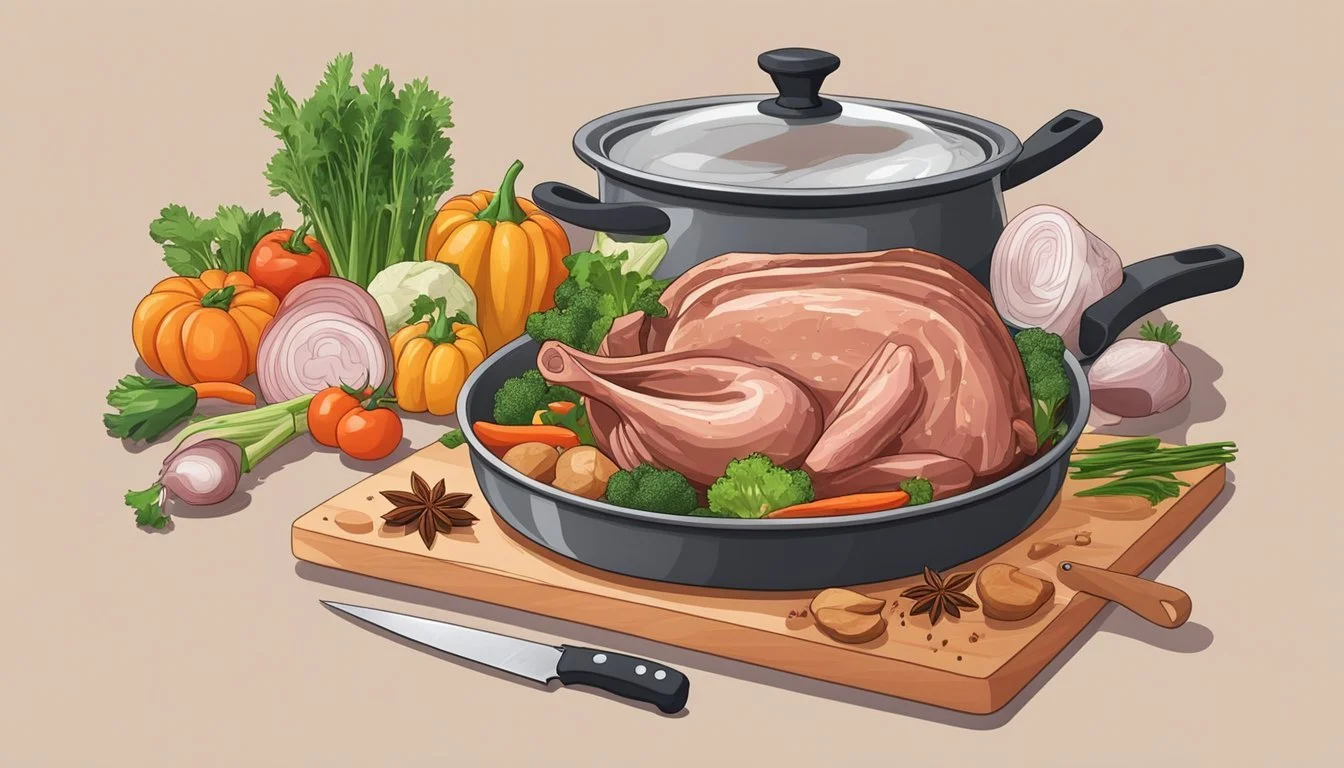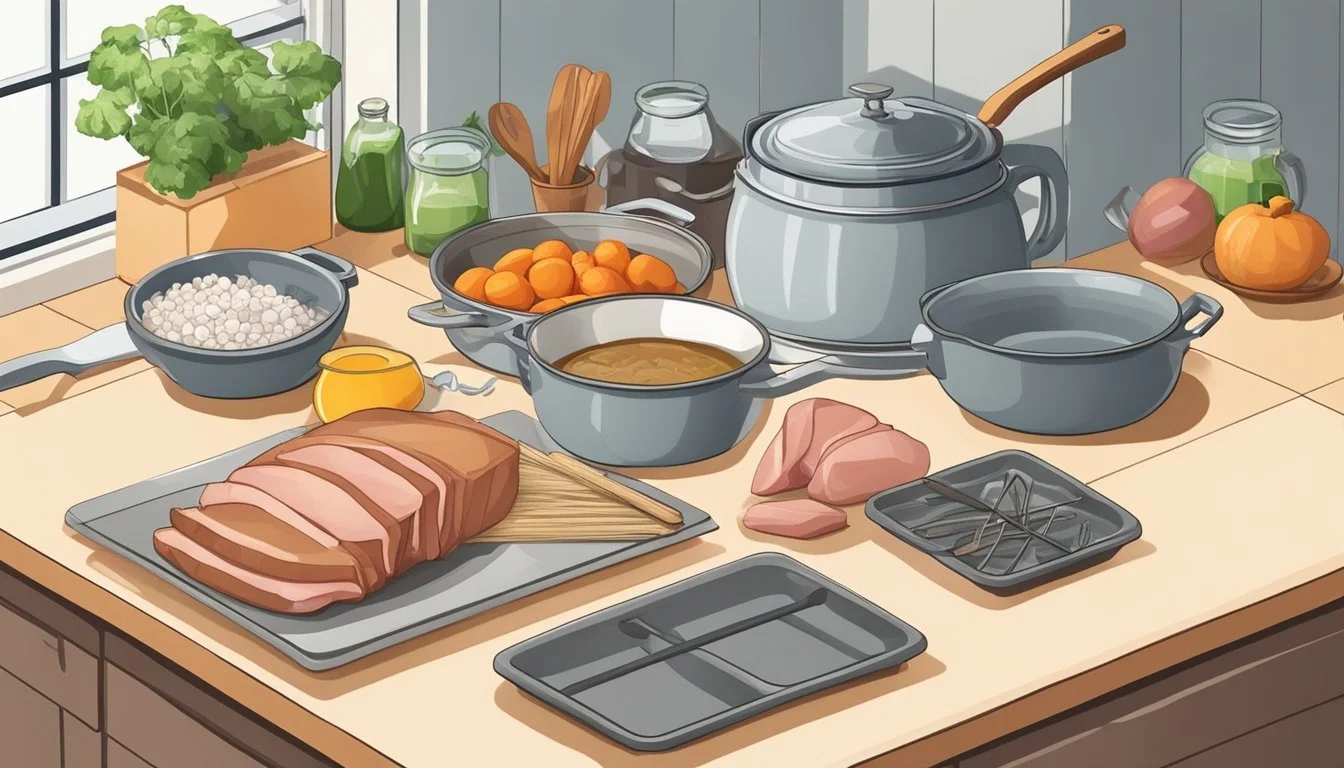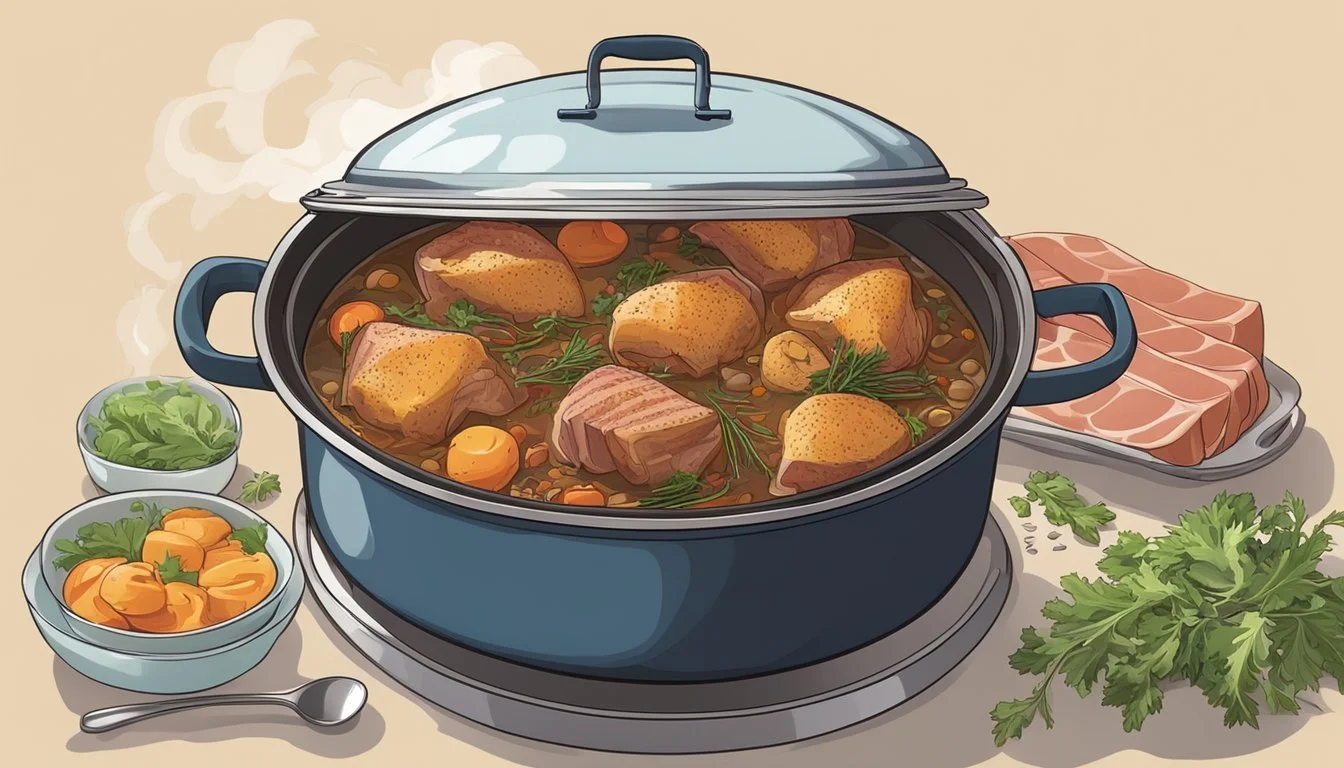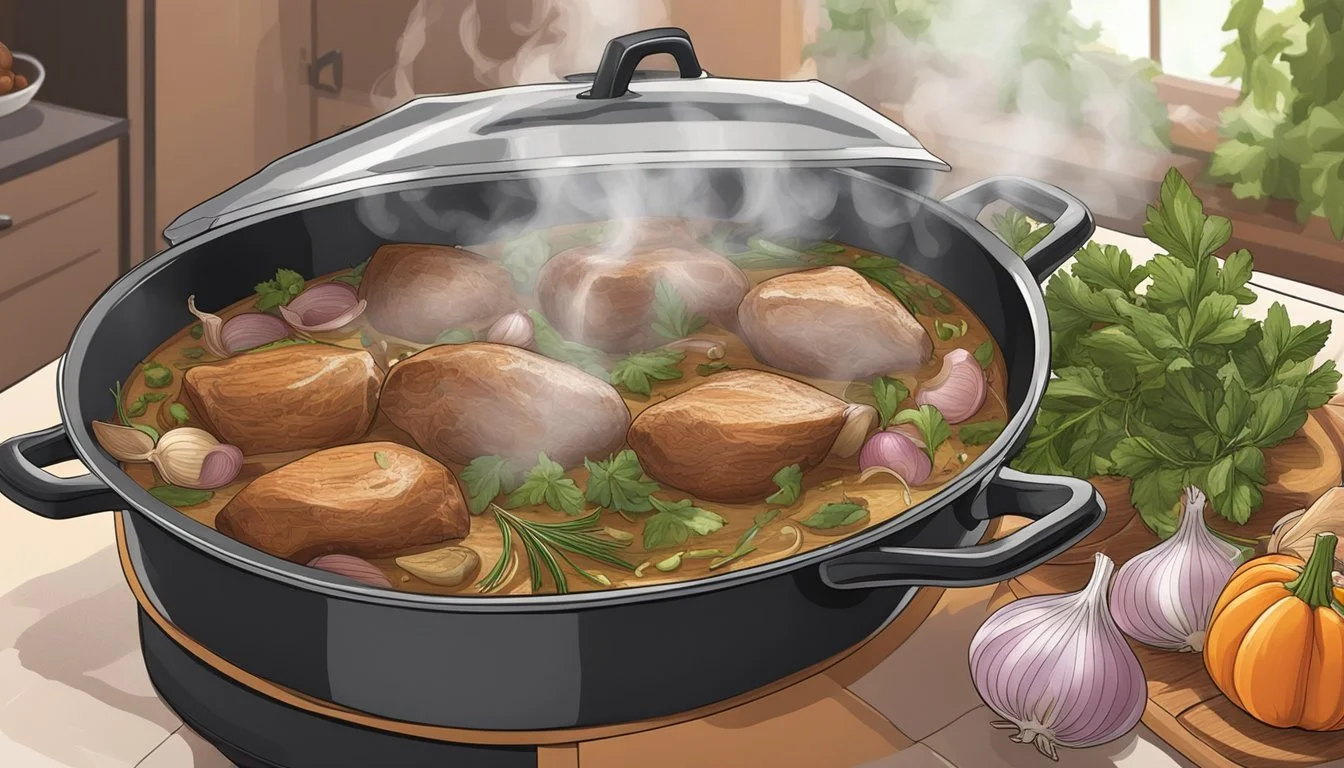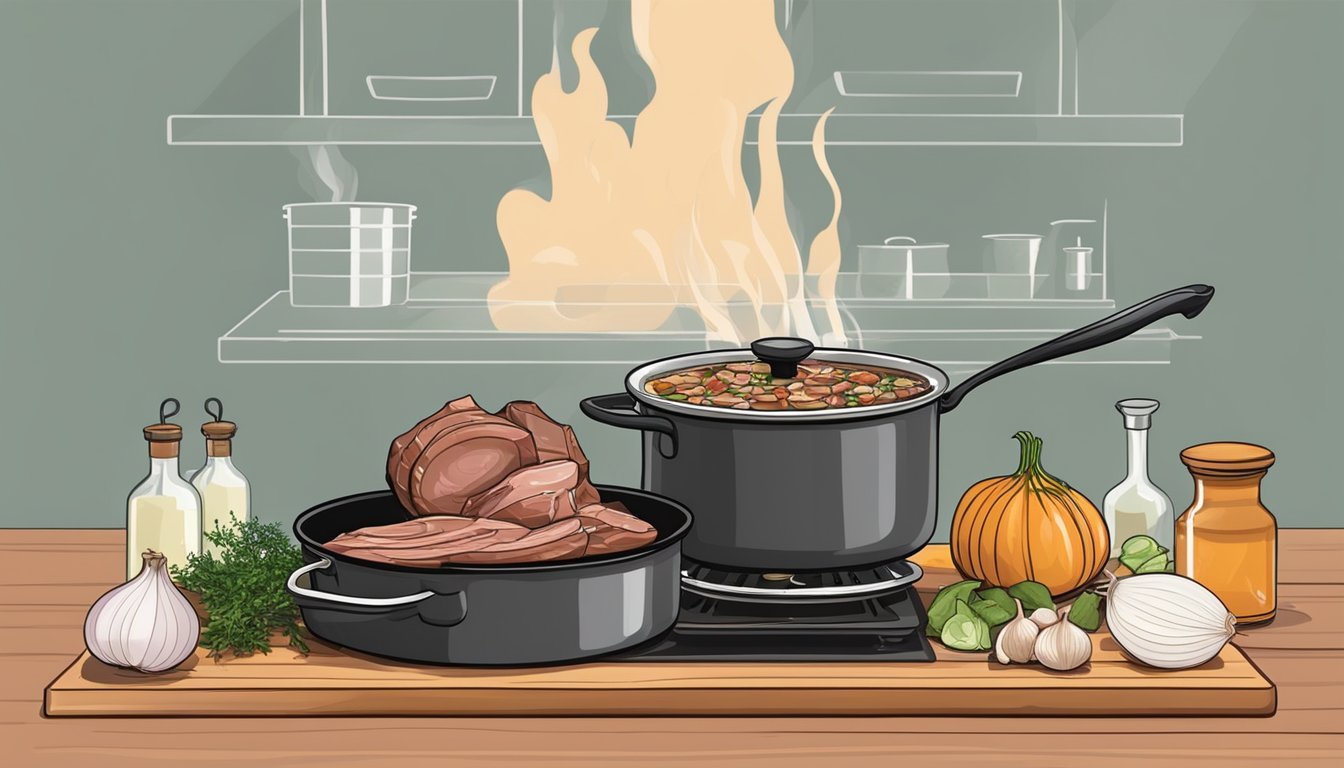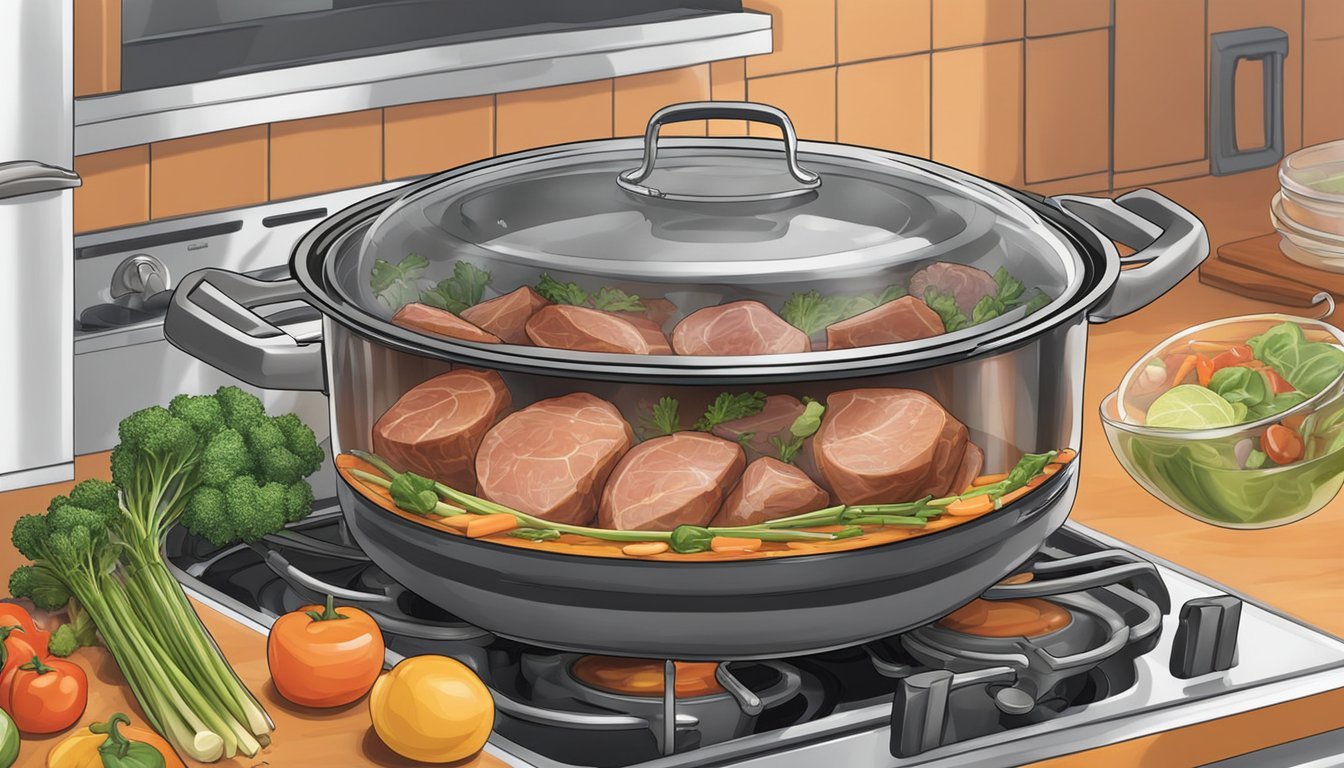DIY Ham Hocks
Your Ultimate Guide to Homemade Charcuterie
Ham hocks, the lower segment of a pig's leg, are a traditional ingredient that packs a punch of flavor into various dishes. Their rich, smoky taste and tender texture make them a versatile component in soups, stews (What wine goes well with stews?), and beans, bringing an unmistakable depth of flavor to the culinary table. The process of preparing ham hocks at home may seem daunting, but with the right guidance, anyone can transform this cut of pork into a delectable addition to their home-cooked meals.
Cooking ham hocks encompasses several methods, including baking, smoking, and simmering. Each technique serves to tenderize the tough meat and infuse it with an array of flavors. Home cooks often utilize brining—a mixture of salt, sugar, and water—as a preliminary step to ensure the hocks retain moisture and absorb seasoning throughout the cooking process. Preparing them at home not only allows for customization of flavors but also adds a personal touch to traditional recipes.
Although the cooking process is time-intensive, the result is well worth the wait. Whether they opt for oven-baking at 350°F until the skin crisps up, or smoking at low temperatures to achieve that sought-after smoky taste, home chefs will find that the slow cooking process used for ham hocks renders them tender and enhances their natural flavors. With patience and attention to detail, cooks can master the art of preparing ham hocks and elevate their home-cooked meals to a new level.
Selecting Quality Ham Hocks
When making ham hocks at home, selecting the right quality is paramount. The process starts with understanding the different types of ham hocks available and knowing the best places to purchase them.
Understanding Types of Ham Hocks
Ham hocks are a cut of pork that comes from the lower leg section of a hog. They are available in two primary forms: smoked and fresh. The smoked variety has a distinct flavor and is often used to enrich the taste of soups and stews, while the fresh variety is more versatile but requires thorough cooking. Fresh ham hocks should have a healthy pink color, with a firm texture.
Where to Buy: Butcher vs Grocery Store
Purchasing high-quality ham hocks can be done at both butchers and grocery stores. However, there are benefits to each option:
Butcher:
Generally offers a higher grade of meat.
Butchers can provide valuable advice on selection and preparation.
May offer more variety in terms of cuts and quality.
Grocery Store:
Usually more convenient with wider accessibility.
Pricing can vary, and there are often pre-packaged options.
Look for labels such as “organic” or “free-range” for indicators of quality.
When buying fresh ham hocks, they should feel firm to the touch and have a fresh, not sour, smell. The meat's color should be consistent throughout, without any graying or brown spots. At the butcher, one can often find a better selection, including heritage breeds or locally-sourced options that are less likely to be available at a grocery store.
Ingredients and Equipment
In preparing ham hocks at home, one must carefully select quality ingredients and gather the necessary equipment. The following outlines the essential components and tools needed for the process.
Essential Ingredients
Smoked Ham Hocks: The star of the dish, typically weighing 1 to 2 pounds each.
Water or Broth: Enough to cover the ham hocks for simmering.
Oil: A small amount for initial searing if desired.
Herbs and Spices
Salt: Essential for seasoning; use kosher salt for a purer taste.
Pepper: Freshly ground black pepper adds a robust flavor.
Garlic: A few cloves can be crushed or minced for aromatic depth.
Bay Leaves: One or two leaves contribute to a subtle, herbal complexity.
Additional Herbs and Spices (Optional):
Onion: A quartered onion enhances the broth with a savory note.
Paprika, Thyme, etc.: Other spices may be used according to the preferred recipe.
Additional Tools
The preparation of ham hocks requires a few basic kitchen utensils:
Large Pot or Dutch Oven: To accommodate the size of the ham hocks during simmering.
Tongs: To safely handle the ham hocks when hot.
Paper Towel: For pat-drying the ham hocks post-rinsing.
This list collectively ensures one is well-prepared to tackle the task of cooking ham hocks at home, resulting in a dish that is both flavorful and tender.
Preparation Before Cooking
Proper preparation of ham hocks is essential for a delicious outcome. One must pay careful attention to rinsing away impurities and preparing the meat's surface.
Rinsing and Drying
The primary step in the preparation process involves thoroughly rinsing the ham hocks under cold water. This step is crucial to remove any excess salt or surface impurities that may be present. After rinsing, one should use paper towels to pat the ham hocks dry. Ensuring the meat is dry helps the seasonings adhere better and also promotes an even cooking process.
Trimming Excess Fat and Skin
While some fat is desirable for flavor and moisture, too much can result in a greasy texture. One should carefully trim away excess fat, leaving just enough to enrich the taste. Similarly, certain recipes may call for scoring or removing portions of the skin. When scoring, make a series of shallow cuts in a crisscross pattern, which allows seasonings to penetrate more deeply and the skin to render more effectively during cooking.
Brining Ham Hocks
Proper brining is critical for infusing ham hocks with savory flavors and ensuring juiciness after smoking. The process involves a saline solution, typically enhanced with additional sweet and aromatic components, in which the ham hocks are submerged for a period of time to absorb the flavors.
Creating the Brine
To create an effective brine, one primarily needs water, salt, and sugar. These ingredients work in tandem to penetrate the meat and retain moisture. While the salt is key for seasoning and firming up the protein, sugar helps to balance the salt's intensity and contributes a subtle sweetness.
Table for Brine Composition:
Ingredient Quantity Water 1 gallon Salt 1.5 cups Sugar 1 cup
Optional aromatic ingredients can be added to the brine for additional flavor, such as bay leaves, peppercorns, and cloves. The brine should be thoroughly mixed until all the salt and sugar are dissolved. Once mixed, it's important to let the brine cool completely before adding the ham hocks to prevent the onset of bacteria.
Soaking Process
Once the brine is prepared and cooled, the ham hocks should be placed in a large, non-reactive container, preferably glass or food-grade plastic, and then completely submerged in the brine solution. If the brine doesn't cover the hocks entirely, additional water mixed with proportional amounts of salt and sugar should be added.
The soaking process typically requires the hocks to be left in the brine for at least 4 hours, though it's often recommended to refrigerate them for a full week for optimal flavor infusion. The refrigeration temperature should be maintained at 40°F (4°C) or less to keep the ham hocks safe from bacterial growth.
In between the soaking phase and the smoking step, the ham hocks should be rinsed under cold water to remove any excess brine and then pat them dry with paper towels. An additional air-drying step can be done by placing them back in the refrigerator, uncovered, to air dry overnight or up to 24 hours, which helps to form a pellicle that allows smoke to adhere better during the smoking process.
The Cooking Process
Cooking ham hocks at home requires an understanding of the proper techniques and temperatures to ensure the meat is tender and flavorful. Here are three methods for preparing ham hocks: boiling, baking, and smoking or grilling.
Boiling the Ham Hocks
First, rinse the ham hocks thoroughly under cold water to remove any debris. In a large pot, submerge the ham hocks in water or stock, adding aromatics like onions and garlic if desired. Bring the liquid to a boil, then reduce to a simmer. Cooking time usually ranges from 2 to 3 hours, or until the meat reaches an internal temperature of 160°F. This method produces tender meat that can be served with the cooking liquid as a flavorful broth.
Baking Method
Preheat your oven to 350°F (177°C). After rinsing the ham hocks with cold water and patting them dry, score the skin, and rub in spices as desired. Place the seasoned ham hocks in a baking dish, adding enough liquid (like broth or water) to cover the bottom of the dish. Cover the dish with foil to trap moisture, and bake until the internal temperature reaches 160°F. Baking may take approximately 2 to 3 hours, depending on the size of the ham hocks. This method helps in achieving a crispy exterior while keeping the inside juicy.
Using a Smoker or Grill
For those seeking a smoky flavor, the smoker or grill provides an excellent method. Heat the smoker or grill to a consistent temperature of around 225°F to 250°F. Ham hocks should be placed on the grill or smoker rack away from direct heat. It's crucial to maintain a low and slow approach, allowing the ham hocks to absorb the smoky flavors over several hours. Generally, it could take up to 4 to 6 hours to reach the suitable internal temperature of 160°F, ensuring the meat is fully cooked yet succulent.
Incorporating Ham Hocks into Dishes
When preparing dishes with ham hocks, their robust flavor and rich fat content can significantly enhance the overall taste. They are traditionally used to both season and add depth to a variety of recipes.
Adding Flavor to Soups and Stews
In soups and stews, ham hocks serve as a powerhouse of flavor. They introduce a smoky depth to the broth that forms the base of these dishes. Here's how to use them:
Begin by simmering the ham hocks in the pot, allowing their fat and collagen to meld into the liquid, thereby creating a flavorful base.
Once cooked, remove the ham hocks, let them cool, then shred the meat into the soup or stew, discarding any excess fat or skin.
Important points to note:
The longer ham hocks simmer within a soup or stew, the more flavor infuses into the broth.
Towards the end of cooking, the meat from the hocks, which is now tender, can be pulled and returned to the pot for an even richer experience.
Serving with Beans and Greens
Ham hocks elevate simple side dishes, like beans and collard greens, transforming them into hearty and satisfying meals.
Beans: When cooking beans, add ham hocks to the pot to allow their savory notes to permeate through the dish.
Steps for Cooking Beans with Ham Hocks Soak beans overnight. Rinse the beans and place them in a pot. Add the ham hocks and cover with water. Simmer until beans are tender. Remove ham hocks, shred meat, and stir back into the beans.
Greens: For greens, especially collard greens, the fat from ham hocks is key in contributing richness to what would otherwise be a light side dish.
To prepare collard greens with ham hocks:
Wash the greens thoroughly and chop them.
Sauté onions and garlic in a pot, then add the ham hocks to introduce a smoky flavor.
Add the greens, and cook until they are soft and infused with the savory meatiness of the ham hocks.
In both cases, seasonings can be adjusted to taste, but often the ham hocks provide ample flavor without needing much additional help.
Finishing Touches
After carefully preparing and cooking ham hocks, the final steps are crucial for ensuring the ideal texture and flavor. These touches will guide one in achieving perfect tenderness, providing serving suggestions, and properly storing any leftovers.
Achieving Ideal Tenderness
To ascertain the ham hock reaches ideal tenderness, one should allow the meat to rest before making further preparations. For instance, if the ham hock was smoked or braised, it should be let to cool slightly until it can be handled. Once cool, one can proceed to remove the meat from the bone using a fork or hands. The meat should be shred finely for easy incorporation into dishes as a rich, flavorful protein.
Serving Suggestions
The succulent, savory shreds of ham hock can be served in numerous ways. Here are a few popular options:
Soups and Stews: Enhance the flavor profile of legume-based soups or hearty stews.
With Rice: Mix into cooked rice along with herbs and spices for a satisfying meal.
Sandwiches: Use as a filling in sandwiches, adding a robust taste to the classic lunch staple.
Each option allows the distinct taste of the ham hock to elevate the overall dish.
Storing Leftovers
Should there be any uneaten ham hock, proper storage is essential to maintain quality. Leftover meat should be placed in an airtight container and can be kept in the refrigerator for up to four days. For longer preservation, one can freeze the ham hock:
Method Container Type Duration Refrigeration Airtight container Up to 4 days Freezing Freezer-safe bag/container Up to 3 months
One should always make sure the meat is cooled down before refrigeration or freezing to prevent bacterial growth.
Safety and Tips
When preparing ham hocks at home, one should pay close attention to safety and proper cooking techniques to ensure both a delicious and healthy meal. It's important to manage sodium levels carefully to maintain the comforting rich flavor of the ham hocks without jeopardizing health.
Proper Handling and Storage
Proper handling and storage are crucial to prevent foodborne illnesses. One should always rinse the ham hocks under cold water to remove any surface debris and excess salt. After rinsing, they should pat the meat dry with clean paper towels. For storage, ham hocks should be kept in the refrigerator at or below 40 °F (4 °C) and consumed within three to five days. If the ham hocks are not to be cooked within this time frame, they should be stored in the freezer, wrapped properly, to extend their shelf life by several months.
Cooking Techniques
Ham hocks can be tender and flavorful when cooked properly. For optimal safety and taste, one should simmer or bake them slowly. If simmering, cover the ham hocks with water or broth and cook at a gentle simmer to ensure even cooking. When baking, preheat the oven to 350 °F (177 °C) and score the skin to allow for better rendering of fat and crisping of the skin.
Adjusting Salt and Sodium Levels
High sodium levels can be of concern when preparing ham hocks. To control this, one might consider preparing a sodium-friendly broth or flavoring with herbs and spices. Opt for low-sodium seasonings or spice blends, as the ham hocks already contain inherent saltiness. When cooking, use fresh or dried herbs to enhance flavor without adding unnecessary sodium. Additionally, one can soak the ham hocks in water for several hours or overnight to reduce the sodium content, changing the water periodically.
By following these guidelines and focusing on proper technique and seasoning adjustments, one can safely prepare and enjoy ham hocks that are both comforting and health-conscious.
Recipes and Variations
When it comes to preparing ham hocks at home, there are classic recipes that have stood the test of time alongside modern variations that introduce a twist to these traditional dishes. Whether one prefers the tried and true or something new, these recipes bring richness and flavor to the table through a diverse mix of ingredients like beans, onions, and fresh herbs.
Classic Recipes
The time-honored approach to ham hocks often involves slow cooking. A traditional recipe may include:
Ingredients: Ham hocks, onions, stock, bay leaves, black peppercorns
Method:
Place ham hocks in a slow cooker.
Add sliced onions, a bay leaf, and a handful of peppercorns.
Pour in enough stock to partially cover the hocks.
Cook on low for 8-10 hours until meat is tender.
For a comforting meal, pairing ham hocks with beans is a must. A simple Ham and White Bean Soup could be made by simmering the cooked hocks with cannellini beans, diced carrots, and herbs like thyme and rosemary.
Modern Twists on Traditional Dishes
Chefs may put a modern spin on these dishes by incorporating unexpected flavors or techniques. An innovative recipe could include:
Ingredients: Ham hocks, brown sugar, smoked paprika, apple, beer
Method:
Create a rub with brown sugar and smoked paprika.
Rub the mixture onto the ham hocks and let it marinate.
Place hocks in a roasting pan, add slices of apple and onions, then pour beer around them.
Roast until caramelized and tender, basting with the cooking liquid.
This method introduces a sweet and smoky flavor complemented by the fruitiness of the apple and the depth of the beer.
Vegetable and Legume Pairings
Vegetables and legumes enrich ham hocks with texture and nutrition. A guide for pairing could look like this:
Beans: White beans or black-eyed peas simmered with ham hocks, seasoned with sage and garlic.
Vegetables: Braised collard greens or sautéed cabbage with fragments of tender ham hock meat.
Potatoes: Creamy mashed potatoes with finely shredded ham hock, incorporated with a touch of rosemary, can elevate this side into a main course.
Each of these pairings creates a balanced dish where the savory flavor of the ham hocks complements the natural taste and texture of the vegetables and legumes.
Conclusion
Cooking ham hocks at home is a simple process that yields delicious and comforting results. The key steps involve thoroughly rinsing them first to remove any excess salt, then soaking if needed to reduce saltiness. Seasoning plays a crucial role – a combination of spices such as garlic powder, paprika, and thyme can elevate the flavor profile.
For those seeking tender meat, the slow cooker method is ideal. It involves adding seasonings, aromatics, and a choice of liquid like broth or beer, then cooking on low heat for several hours until the meat falls off the bone effortlessly.
For dishes like beans and ham hocks or ham hocks with collard greens, an important preparatory step is to soak the beans or greens to ensure even cooking. With patience and care, the ham hocks will impart a rich, savory taste to the accompanying ingredients.
One does not need to be a culinary expert to achieve a comforting homemade meal featuring ham hocks. With this step-by-step guide, anyone can prepare this dish with confidence, whether they're a seasoned cook or a beginner in the kitchen. The result is a deeply flavorful and satisfying dish that exemplifies home cooking at its best.

